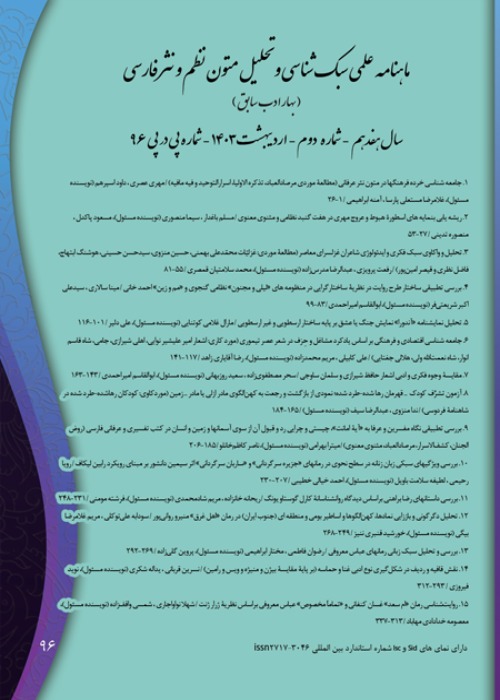Stylistic analysis of the introductory poems to the Persons of the Resistance of the Islamic Revolution and the Sacred defense (Based on a review of the poetry of Fifteen poets)
Part of our country's sustainability literature is introductory poems describing and mentioning the personalities of the revolution and holy defense (leaders, theorists, fighters, martyrs, missing persons, freedmen, veterans and families of martyrs). In this article, the poems of 15 poets of stability have been studied from the point of view of stylistics at the linguistic, literary and intellectual level. A total of 145 poems were collected from the poets under study, who dedicated them directly to a person or persons. He is a prominent figure in the poems dedicated to Imam Khomeini. The popular martyrs of the revolution. Among the holy defense personalities are warriors, Basijis, martyrs, veterans, missing persons, and freedmen. Most of the introductory poems are in Hamid Sabzevari's poetry.
The research was conducted in a descriptive-analytical manner and in all the works of the relevant poets, the poems that were written by a person or persons related to the Islamic Revolution and the Holy Defense were selected as a statistical population.
The format of the sonnet is superior in describing the characters. At the linguistic level, linguistic reflections can be seen in the poetry of Moallem, Sabzevari, Mirshkak and Avesta, the most prominent of which is Ali Moallem, who has used ancient words and syntactic structure. Other poets have used simple and smooth language, gentle weights, rhymes and short lines.
In inner music, attention is paid to full puns and types of repetitions, and in the use of the word, the words archaism, Arabic, lyrical and mystical are prominent. At the literary level, in the expressive industry, simile and in the rhetorical industry, allusion is the first array, as well as the arrays of symbolism, recognition, ambiguity, and context. At the intellectual level, mourning for the characters is the most numerous, followed by praise of the characters, a description of the stability and courage of the characters, and part of the poems describe the popular uprising and the victory of the Islamic Revolution.
- حق عضویت دریافتی صرف حمایت از نشریات عضو و نگهداری، تکمیل و توسعه مگیران میشود.
- پرداخت حق اشتراک و دانلود مقالات اجازه بازنشر آن در سایر رسانههای چاپی و دیجیتال را به کاربر نمیدهد.



